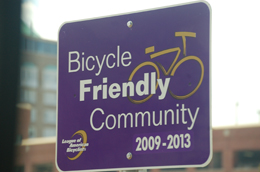May is bike month: Support health and reinforce place by becoming a Bicycle Friendly Community
Whether biking to commute or for recreation; to maintain health or the environment, celebrate May as National Bike Month and help your community become a Bicycle Friendly Community.
 May is National Bike Month and while many are aware of the health reasons to make biking a part of your life, there are also many reasons that communities should promote biking. If your community is bicycle friendly it helps reinenforce the sense of place for residents and visitors.
May is National Bike Month and while many are aware of the health reasons to make biking a part of your life, there are also many reasons that communities should promote biking. If your community is bicycle friendly it helps reinenforce the sense of place for residents and visitors.
Photo at right: A Bicycle Friendly Community sign in Traverse City, Mich. Photo by Kurt Schindler.
The Bicycle Friendly Community (BFC) program is a national initiative to help communities improve conditions for bicycling. A program of the League of American Bicyclists, the BFC designation recognizes communities that welcome cyclists by providing safe accommodations for biking and encouraging people to bike for transportation and recreation.
The BFC program began in 1996 and consists of four award levels – Platinum, Gold, Silver, and Bronze – based on community support for the Five Es:
- Engineering – Includes the physical infrastructure of the community that either enables residents to bike or discourages the activity. For avid cyclists, any old paved surface will do, but because the majority of community members are novice cyclists, the conditions must be right to create a safe and welcoming environment for two wheels. Infrastructure such as shared-use paths, bike lanes, bike parking, timed traffic lights, and racks on busses are all necessary to be a Bicycle Friendly Community.
- Education – Sharing the road is an important aspect of being bicycle friendly and motorists and cyclists alike can sometimes cause each other anxiety, frustration, and outright rage when not following the rules of the road. Therefore, outreach and education can make for better cyclists and better motorists that together make for safer cycling.
- Encouragement – Trying something for the first time often takes encouragement from others and beginner and novice cyclists might need a ‘push’ to get them started. Community events, like celebrating National Bike Month, group rides, races, and streets open to cyclists only all help to create greater awareness and heighten the interests of community members. There is a physical infrastructure component to encouragement as well and residents that cannot afford bikes or don’t have the living space for bikes (e.g. those in college dorms) can benefit from bike sharing programs.
- Enforcement – Enforcement applies to motorists and bicyclists alike, and helps to keep everyone safe and the biking experience fun. Most communities prohibit biking on sidewalks in central business districts for good reasons – bicycle-pedestrian collisions are likely with all the recessed entries characteristic of downtown shops and restaurants. So, ticketing cyclists and motorists for not obeying traffic laws or local ordinances helps keep awareness high and everyone safe. Further, public safety officers on bikes can help with enforcement and education.
- Evaluation & Planning – In order to improve something, it must be evaluated. A community bicycle advisory committee can help local officials and planners assess what’s working and not, plan for needed improvements, and expand public support for Bicycle Friendly Community improvements.
Michigan currently has eight Bicycle Friendly Communities: Ann Arbor, Houghton, Grand Rapids, Lansing, Marquette, Midland, Portage, and Traverse City. Ann Arbor has the highest level of recognition in the state with a Silver designation; all other Michigan communities have earned the Bronze level to date. As a state, Michigan ranks No. 12 out of the 50 states in terms of being bicycle friendly. The state earns the highest marks for “Policies and Programs” and “Education and Enforcement” that support cycling and the lowest marks for “Infrastructure and Funding” and “Evaluation and Planning.”
Besides the BFC program’s own stated benefits that include promotion of community amenities, technical assistance, benchmarking, and inspiration to do more, creating a more bicycle (and pedestrian) friendly community is a placemaking initiative that can help to retain and attract talented individuals. When working with communities, Michigan State University Extension often emphasizes the importance of being a part of the New Economy. Increasingly, individuals seek communities that have plentiful recreation opportunities and transportation options beyond than the car.
So, celebrate May as National Bike Month and apply to become a Bicycle Friendly Community.
- A Bicycle Friendly Community sign; Traverse City, Kurt Schindler
- Supportive infrastructure (engineering ) is one key to being bicycle friendly; Traverse City, Kurt Schindler



 Print
Print Email
Email



